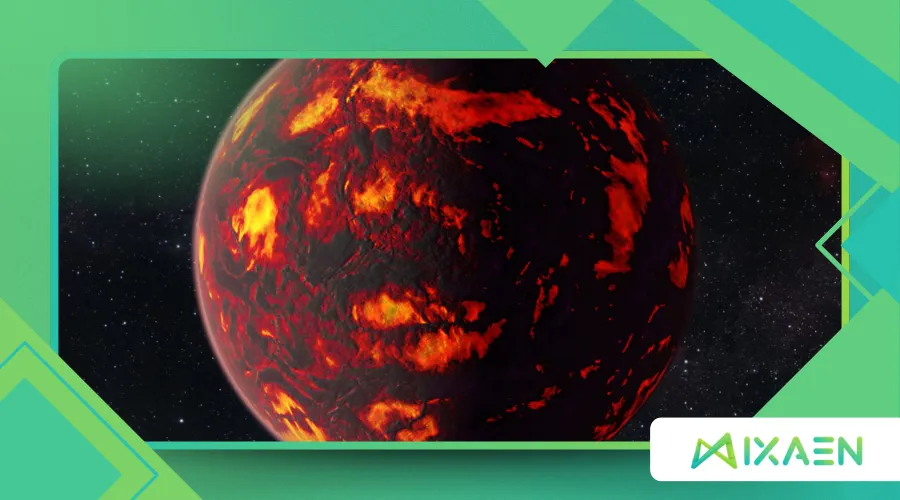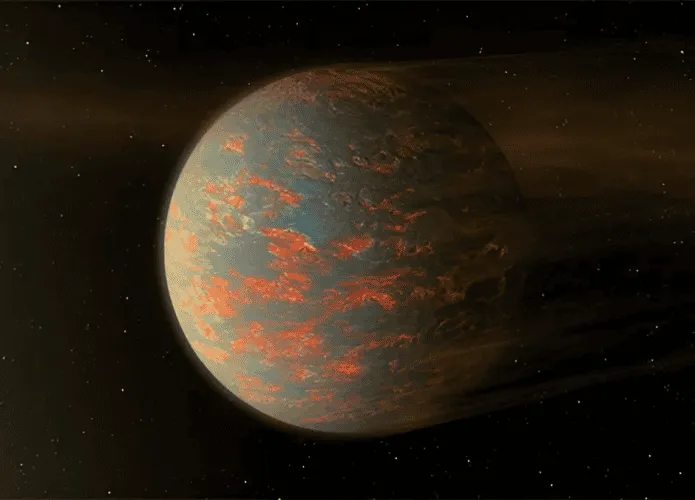55 Cancri e: The Most Mysterious Lava Planet in the Universe

Imagine a world where oceans boil with molten rock, skies shimmer with silicate clouds, and diamonds might form mountains under a star’s relentless glare.
Anúncios
This is the enigmatic realm of 55 Cancri e, a super-Earth 41 light-years away that captivates astronomers and dreamers alike.
Why does this fiery exoplanet, bathed in extreme conditions, hold such allure for those probing the cosmos?
Its secrets challenge our understanding of planetary science, offering clues to the universe’s vast diversity.
A Scorching Super-Earth Defying Expectations
Nestled in the constellation Cancer, 55 Cancri e orbits a star slightly dimmer than our Sun, completing a dizzying revolution every 17 hours.
This proximity results in surface temperatures soaring to 2,400°C (4,352°F), hot enough to melt rock into a global lava ocean.
Unlike Earth’s dynamic crust, this planet’s surface is a churning, molten spectacle, shaped by intense stellar radiation.
Its size—roughly twice Earth’s radius and nine times its mass—classifies it as a super-Earth, yet its extreme environment sets it apart from any world we know.
Recent observations by the James Webb Space Telescope (JWST) have unveiled tantalizing details.
In 2024, astronomers detected potential atmospheric gases, marking the strongest evidence yet of a rocky exoplanet with an atmosphere outside our solar system.
This finding, published in Nature (May 2024), suggests a thin veil of volatile gases, possibly carbon dioxide or monoxide, persisting despite the planet’s hellish conditions.
Such an atmosphere defies expectations, as intense stellar radiation should strip away gaseous layers.
This discovery sparks questions about how 55 Cancri e retains its atmosphere, hinting at dynamic processes like volcanic outgassing or exotic chemical interactions.
Additionally, the implications of this discovery extend to our understanding of other exoplanets, suggesting that atmospheric retention may be more common than previously thought.
A Diamond in the Rough?
The planet’s composition adds another layer of intrigue.
Early studies proposed that 55 Cancri e could be a “carbon-rich” world, potentially harboring vast deposits of graphite or even diamonds.
Its high carbon-to-oxygen ratio, inferred from its host star’s composition, suggests a geology unlike Earth’s silicate-dominated crust.
Imagine a landscape where pressure and heat forge diamond peaks, glittering under a starlit sky—a planetary jewel box.
While direct evidence of diamond mountains remains speculative, the idea fuels scientific curiosity about carbon-rich exoplanets and their formation.
Consider a hypothetical scenario: a probe landing on 55 Cancri e would encounter a surface where molten lava flows carve glowing rivers, and silicate clouds condense into sparkling dust.
The probe’s sensors might detect carbon compounds transforming under extreme pressure, forming crystalline structures.
This vision, while speculative, underscores the planet’s alien geology, pushing scientists to rethink planetary evolution.
In fact, the study of such carbon-rich worlds can lead to new insights about the formation of planets and the potential for similar compositions elsewhere in the universe.
+ Kepler-7b: The Most Reflective Gas Planet Ever Discovered
A Tidally Locked Enigma
The planet’s tidal locking creates a stark dichotomy.
One hemisphere bakes in perpetual daylight, while the other languishes in eternal night.
This extreme contrast drives unique atmospheric and geological dynamics.
The dayside, scorched by its star, likely hosts a seething lava ocean, while the nightside may cool enough for lava to solidify, creating a crust pockmarked by volcanic activity.
This duality makes 55 Cancri e a natural laboratory for studying heat transfer and atmospheric circulation on tidally locked worlds.
A 2025 study posted on X highlighted a “magma temperature-cloud feedback” mechanism, explaining weather variability on 55 Cancri e.
Hotter magma on the dayside vaporizes into silicate clouds, which reflect stellar radiation, cooling the surface temporarily before condensing back into lava.
This cycle, driven by extreme temperature gradients, creates a dynamic interplay absent on Earth-like planets.
The statistic is striking: the dayside temperature can fluctuate by up to 300°C due to this feedback, a variability unseen in our solar system.
| Feature | Dayside | Nightside |
|---|---|---|
| Temperature | ~2,400°C (4,352°F) | ~1,100°C (2,012°F) |
| Surface State | Molten lava ocean | Solidified crust, volcanic |
| Atmospheric Activity | Silicate cloud formation | Potential gas condensation |
This unique environment provides a compelling opportunity to study how life might adapt to extreme conditions, potentially informing our search for habitable worlds.

Volcanic Fury and Atmospheric Resilience
Volcanism likely plays a pivotal role in 55 Cancri e’s mystique.
Its high gravity—nearly nine times Earth’s—suggests short, stubby volcanoes spewing lava across the surface.
A 360° visualization by NASA’s Exoplanet Exploration Program (2023) depicts these volcanoes as glowing beacons in a molten landscape.
Unlike Earth’s towering stratovolcanoes, these features would be squat, overwhelmed by the planet’s intense pull.
Yet, their activity could replenish the atmosphere, countering losses from stellar radiation.
Picture a volcanic eruption on 55 Cancri e: a fountain of molten rock bursts skyward, releasing gases like carbon dioxide that mingle with silicate vapors.
These emissions could form a tenuous atmosphere, detectable by JWST’s sensitive instruments.
This scenario illustrates how volcanism might sustain the planet’s gaseous envelope, a process akin to Io’s sulfur-driven volcanism in our solar system, but amplified by extreme conditions.
Moreover, understanding the volcanic activity on 55 Cancri e can provide insights into similar processes on other exoplanets, enhancing our knowledge of planetary atmospheres.
++ KELT-9b: The Exoplanet With the Highest Temperature Ever Recorded
A Cosmic Puzzle for Planetary Formation
The planet’s characteristics challenge conventional models of planetary formation.
Its close orbit and high density suggest it formed closer to its star than Earth did to the Sun, yet its carbon-rich nature hints at a unique evolutionary path.
Did 55 Cancri e migrate inward from a cooler orbit, or did it form in situ, bathed in stellar heat from birth?
This question drives research into disk migration and core accretion, processes that shape planetary systems.
The analogy of 55 Cancri e as a cosmic forge is apt.
Just as a blacksmith hammers raw metal into a refined blade, the planet’s star forges its surface and atmosphere through relentless heat and radiation.
This forging process creates a world that is both destructive and generative, reshaping our understanding of what planets can be.
As scientists continue to study 55 Cancri e, they hope to unlock secrets that could apply to the formation of other rocky planets in the universe.

| Parameter | 55 Cancri e | Earth |
|---|---|---|
| Radius | ~2x Earth’s | 6,371 km |
| Mass | ~9x Earth’s | 5.97×10²⁴ kg |
| Orbital Period | 17 hours | 365.25 days |
| Surface Temperature | Up to 2,400°C (4,352°F) | ~15°C (59°F) |
| Atmosphere | Thin, possibly CO₂/CO | Nitrogen, Oxygen |
For more information on exoplanets and the latest discoveries, you can visit the NASA Exoplanet Exploration website.
The Broader Implications for Astronomy
The study of 55 Cancri e extends beyond its fiery surface.
It informs the search for habitable exoplanets by highlighting the diversity of planetary environments.
If a lava world can retain an atmosphere, what might cooler, Earth-like planets harbor?
The JWST’s ability to detect gases on distant worlds signals a new era in exoplanet science, where spectroscopy unravels the chemistry of alien skies.
Moreover, 55 Cancri e’s carbon-rich composition prompts questions about the prevalence of such planets.
Are diamond worlds common in the galaxy, or is this super-Earth an outlier?
Future missions, like NASA’s UVEX (UltraViolet EXplorer) set for launch in 2030, may provide clues by studying ultraviolet signatures from distant exoplanets, potentially revealing more about their compositions.
The implications of these discoveries could reshape our search for life beyond Earth, guiding future explorations toward the most promising targets.
A Call to Cosmic Curiosity
The allure of 55 Cancri e lies in its defiance of earthly norms.
Its lava oceans, potential diamond mountains, and resilient atmosphere challenge scientists to expand their paradigms.
As telescopes like JWST peel back the layers of this mysterious world, each discovery reshapes our cosmic perspective.
For astronomy enthusiasts, 55 Cancri e is not just a planet—it’s a testament to the universe’s boundless creativity.
By blending cutting-edge science with vivid imagery, this exploration of 55 Cancri e offers a glimpse into a world that is both alien and inspiring.
Its study pushes the boundaries of what we believe planets can be, inviting us to wonder what other mysteries await in the starry depths.
As we continue to explore the cosmos, each new finding only deepens our curiosity about the universe and our place within it.
